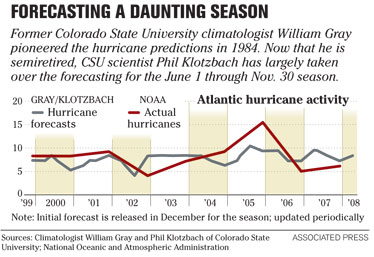ASSOCIATED PRESS
Bud Dail displays one of his custom-made sheets of plywood that he uses to board up the windows when hurricanes threaten his trailer in Surf City, N.C. Dail, whose trailer sits no more than 100 yards from the high-tide line, heeds warnings about specific storms but puts little stock in the annual hurricane season forecast.
|
|
Forecasts spur preparation, says Hurricane Center chief
STORY SUMMARY »
Hawaii forecasters generally are on the mark with the number of storm systems predicted in the Central Pacific during hurricane season.
But there's no way of predicting this far in advance if one of those storms will hit the islands.
The value of forecasts is to get people thinking about hurricanes and getting prepared, says Jim Weyman, Central Pacific Hurricane Center director.
People need personal action plans to prepare, he emphasized, pointing out this could mean the difference between being a victim or survivor.
FULL STORY »
Storm forecasts for the Central Pacific have been relatively accurate since 2000, says Jim Weyman, director of the Central Pacific Hurricane Center.
"We were very close except one year where we forecast two or three (hurricanes) and there were five."
That was in 2006 when three weak systems (tropical depressions) occurred late in the season -- two in September and one in October.
"Usually when we get systems that are late, they are due more to El Nino conditions of warm water existing to the south of us," Weyman said.
Forecasters this year are predicting three to four tropical storm systems in the Central Pacific from June 1 to Nov. 30, a slightly below-average hurricane season.
 La Nina conditions, when ocean temperatures are colder, have weakened since February and may become neutral by the end of the summer, Weyman said. Typically, there is less cyclone activity in the Central Pacific during an active La Nina or neutral ocean conditions, he said.
La Nina conditions, when ocean temperatures are colder, have weakened since February and may become neutral by the end of the summer, Weyman said. Typically, there is less cyclone activity in the Central Pacific during an active La Nina or neutral ocean conditions, he said.
Central Pacific tropical cyclones have generally been associated with El Nino, Weyman noted. The four top years for hurricanes since 1971 have been El Nino years, he said.
Pacific equatorial waters are warmer during El Nino, which disrupt the ocean-atmosphere system and cause worldwide climate changes.
What's known as the Pacific Decadal Oscillation is another factor affecting the seasonal outlook for hurricanes, Weyman said. It involves long-term fluctuation of sea-surface heights and temperatures in the Pacific Ocean.
"Right now we're in a down phase of the Pacific Decadal Oscillation," Weyman said. "The most active period was in the 1970s to 1994-1995. Since 1995, we have been in less active years except for 1997, a very strong El Nino year."
For La Nina and PDO years, he said, "A great deal of difference in the number of systems can occur. For some years it's been zero. In one year, 1985, there were eight systems in a La Nina year but it is not a strong correlation."
When three to four storm systems are predicted in the Central Pacific, Weyman said, "We are not saying exactly where those three or four will be.
"The science is not there yet to predict exactly where the systems during the season will go."
One reason for issuing forecasts, Weyman stressed, "is to get people thinking about hurricanes and preparedness."
The National Weather Service's mission is protection of life and property, he pointed out, adding that there are two ways to do that.
"One is to issue very accurate warnings, watches, forecasts and those kinds of things. Second is, we do a lot of talks to a lot of different groups ... explaining about hurricanes, what they are, how they move and emphasizing that people need personal action plans."
Whether a person becomes a victim or survivor of a disaster sometimes depends whether he or she is prepared with an action plan, Weyman said.
People should have five to seven days worth of food, water and survival gear, such as a radio and flashlights, he said.
"Government is not going to be able to come to every household and help them. People need to be able to survive pretty much by themselves."

